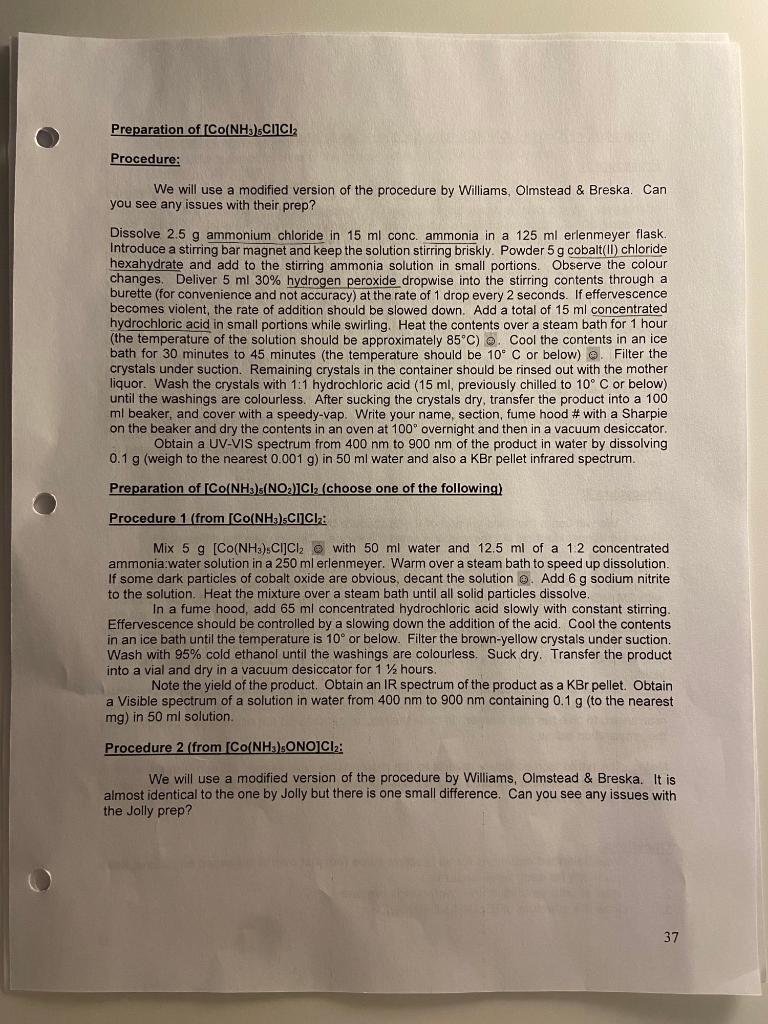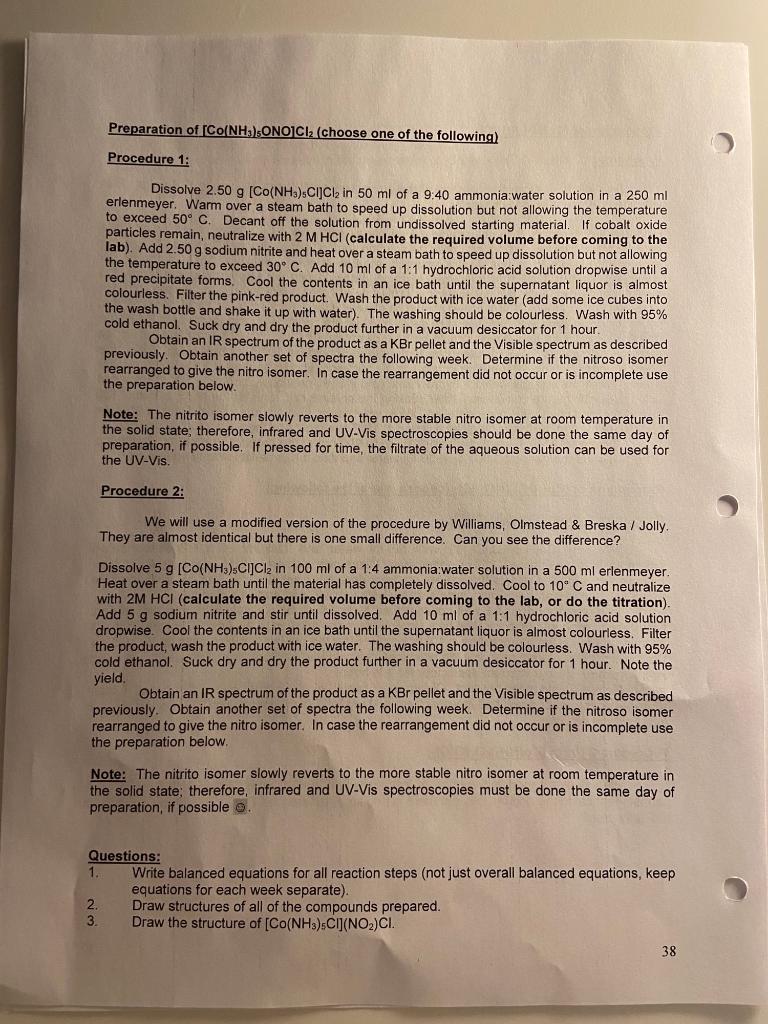I've attached the procedure below and here are the questions that I need help with:
1. Write balanced equations for all reaction steps (not just overall balanced equations, keep equations for each week separate).
2. Draw structures of all of the compounds prepared. 3. Draw the structure of [Co(NH3)5Cl](NO2)Cl. 4. Draw the structure of [Co(NH3)4(NO2)Cl](NH3)Cl. 5. Draw the structure of [Co(NH3)6][Co(NO2)2(NH3)4]Cl4. 6. What is the main difference in the preparation of [Co(NH3)5NO2]Cl2 and [Co(NH3)5ONO]Cl2? 7. How do you obtain 2 M HCl from concentrated HCl?


Procedure: We will use a modified version of the procedure by Williams, Olmstead \& Breska. Can you see any issues with their prep? Dissolve 2.5g ammonium chloride in 15ml conc. ammonia in a 125ml erlenmeyer flask. Introduce a stirring bar magnet and keep the solution stirring briskly. Powder 5g cobalt(II) chloride hexahydrate and add to the stirring ammonia solution in small portions. Observe the colour changes. Deliver 5ml30% hydrogen peroxide dropwise into the stirring contents through a burette (for convenience and not accuracy) at the rate of 1 drop every 2 seconds. If effervescence becomes violent, the rate of addition should be slowed down. Add a total of 15ml concentrated hydrochloric acid in small portions while swirling. Heat the contents over a steam bath for 1 hour (the temperature of the solution should be approximately 85C ) . Cool the contents in an ice bath for 30 minutes to 45 minutes (the temperature should be 10C or below) . Filter the crystals under suction. Remaining crystals in the container should be rinsed out with the mother liquor. Wash the crystals with 1:1 hydrochloric acid ( 15ml, previously chilled to 10C or below) until the washings are colourless. After sucking the crystals dry, transfer the product into a 100 ml beaker, and cover with a speedy-vap. Write your name, section, fume hood \# with a Sharpie on the beaker and dry the contents in an oven at 100 overnight and then in a vacuum desiccator. Obtain a UV-VIS spectrum from 400nm to 900nm of the product in water by dissolving 0.1g (weigh to the nearest 0.001g ) in 50ml water and also a KBr pellet infrared spectrum. Preparation of [Co(NH3)5(NO2)]Cl2 (choose one of the following). Mix 5g[Co(NH3)3ClClCl2 with 50ml water and 12.5ml of a 1.2 concentrated ammonia:water solution in a 250ml erlenmeyer. Warm over a steam bath to speed up dissolution. If some dark particles of cobalt oxide are obvious, decant the solution @. Add 6g sodium nitrite to the solution. Heat the mixture over a steam bath until all solid particles dissolve. In a fume hood, add 65ml concentrated hydrochloric acid slowly with constant stirring. Effervescence should be controlled by a slowing down the addition of the acid. Cool the contents in an ice bath until the temperature is 10 or below. Filter the brown-yellow crystals under suction. Wash with 95% cold ethanol until the washings are colourless. Suck dry. Transfer the product into a vial and dry in a vacuum desiccator for 11/2 hours. Note the yield of the product. Obtain an IR spectrum of the product as a KBr pellet. Obtain a Visible spectrum of a solution in water from 400nm to 900nm containing 0.1g (to the nearest mg ) in 50ml solution. Procedure 2 (from [Co(NH3)5ONOICl2 : We will use a modified version of the procedure by Williams, Olmstead \& Breska. It is almost identical to the one by Jolly but there is one small difference. Can you see any issues with the Jolly prep? Preparation of [Co(NH3)5ONOOH2 (choose one of the following) Procedure 1: Dissolve 2.50g[Co(NH3)5CljCl2 in 50ml of a 9:40 ammonia:water solution in a 250ml erlenmeyer. Warm over a steam bath to speed up dissolution but not allowing the temperature to exceed 50C. Decant off the solution from undissolved starting material. If cobalt oxide particles remain, neutralize with 2MHCl (calculate the required volume before coming to the lab). Add 2.50g sodium nitrite and heat over a steam bath to speed up dissolution but not allowing the temperature to exceed 30C. Add 10ml of a 1:1 hydrochloric acid solution dropwise until a red precipitate forms. Cool the contents in an ice bath until the supernatant liquor is almost colourless. Filter the pink-red product. Wash the product with ice water (add some ice cubes into the wash bottle and shake it up with water). The washing should be colourless. Wash with 95% cold ethanol. Suck dry and dry the product further in a vacuum desiccator for 1 hour. Obtain an IR spectrum of the product as a KBr pellet and the Visible spectrum as described previously. Obtain another set of spectra the following week. Determine if the nitroso isomer rearranged to give the nitro isomer. In case the rearrangement did not occur or is incomplete use the preparation below. Note: The nitrito isomer slowly reverts to the more stable nitro isomer at room temperature in the solid state; therefore, infrared and UV-Vis spectroscopies should be done the same day of preparation, if possible. If pressed for time, the filtrate of the aqueous solution can be used for the UV-Vis. Procedure 2: We will use a modified version of the procedure by Williams, Olmstead \& Breska / Jolly. They are almost identical but there is one small difference. Can you see the difference? Dissolve 5g[Co(NH3)5ClCCl2 in 100ml of a 1:4 ammonia:water solution in a 500ml erlenmeyer. Heat over a steam bath until the material has completely dissolved. Cool to 10C and neutralize with 2MHCl (calculate the required volume before coming to the lab, or do the titration). Add 5g sodium nitrite and stir until dissolved. Add 10ml of a 1:1 hydrochloric acid solution dropwise. Cool the contents in an ice bath until the supernatant liquor is almost colourless. Filter the product, wash the product with ice water. The washing should be colourless. Wash with 95% cold ethanol. Suck dry and dry the product further in a vacuum desiccator for 1 hour. Note the yield. Obtain an IR spectrum of the product as a KBr pellet and the Visible spectrum as described previously. Obtain another set of spectra the following week. Determine if the nitroso isomer rearranged to give the nitro isomer. In case the rearrangement did not occur or is incomplete use the preparation below. Note: The nitrito isomer slowly reverts to the more stable nitro isomer at room temperature in the solid state; therefore, infrared and UV-Vis spectroscopies must be done the same day of preparation, if possible 0 . Questions: 1. Write balanced equations for all reaction steps (not just overall balanced equations, keep equations for each week separate). 2. Draw structures of all of the compounds prepared. 3. Draw the structure of [Co(NH3)5Cl](NO2)Cl








